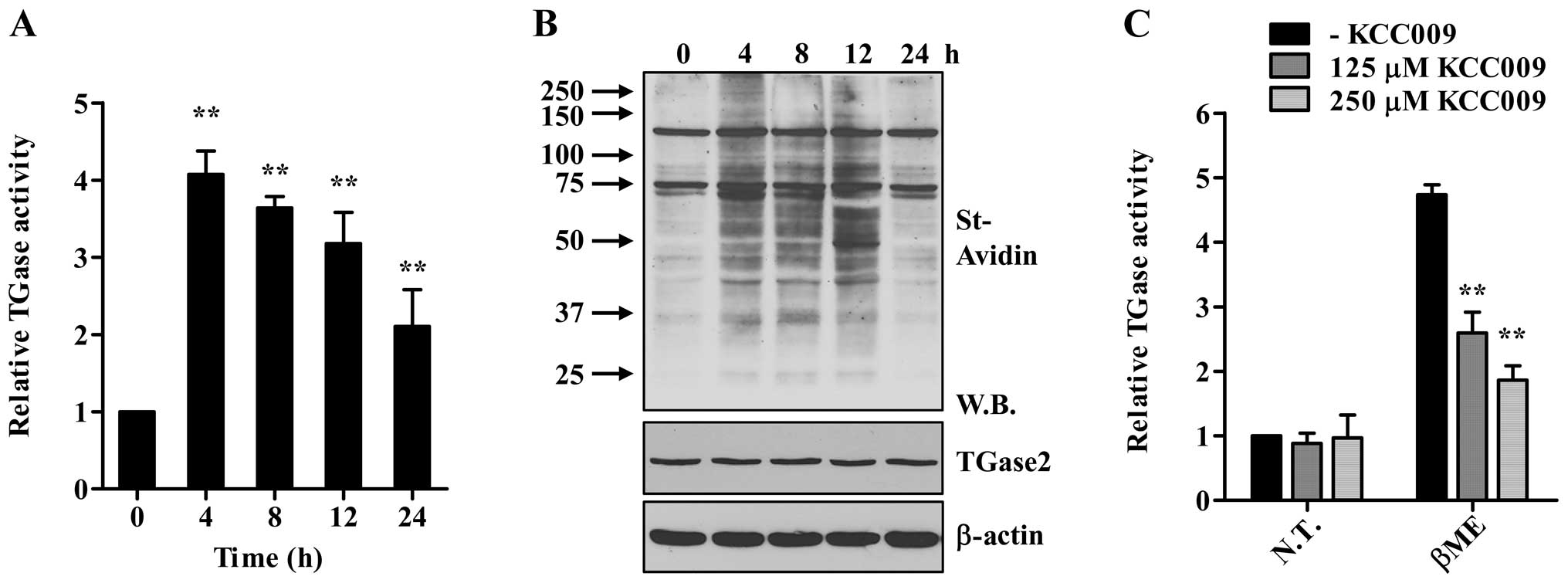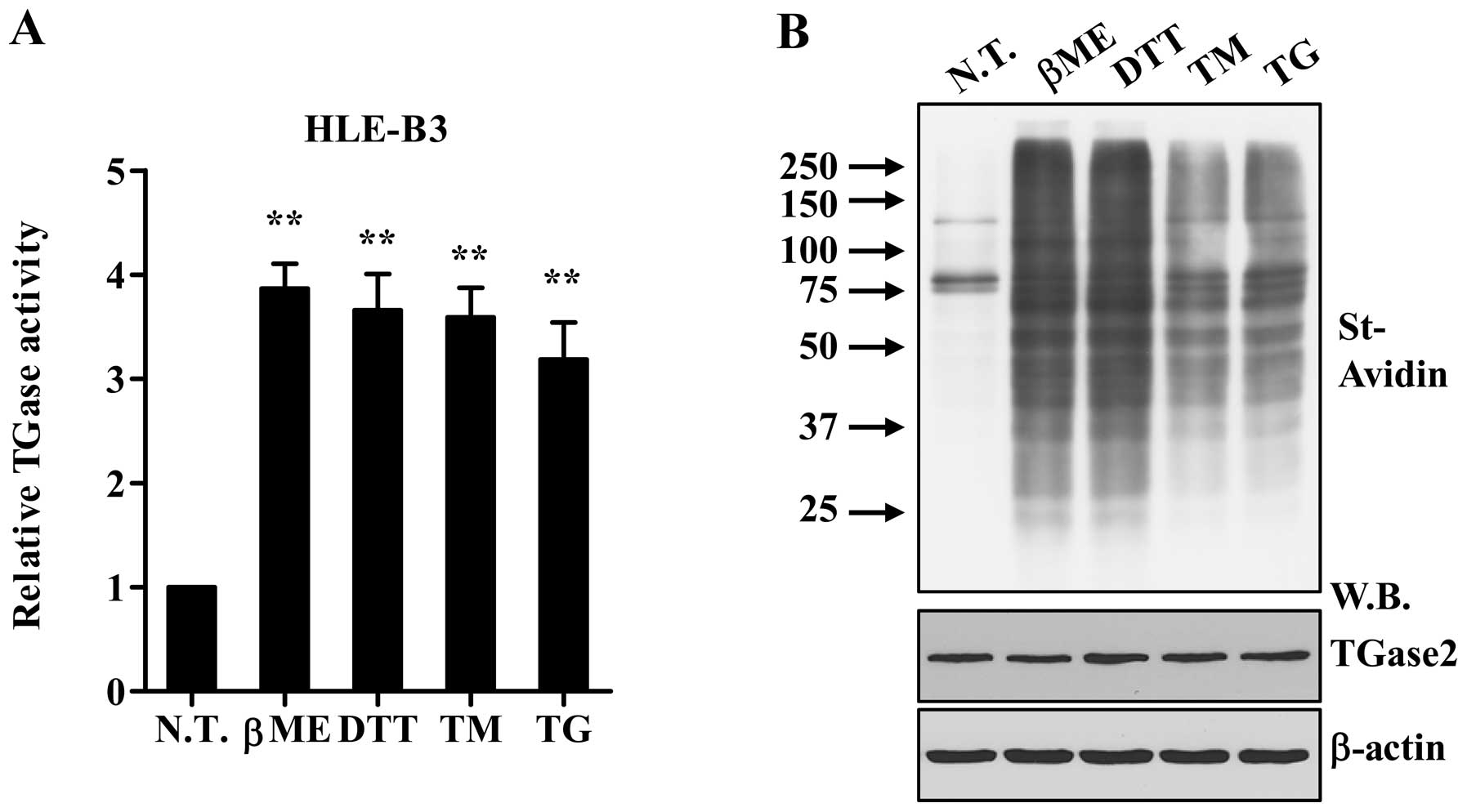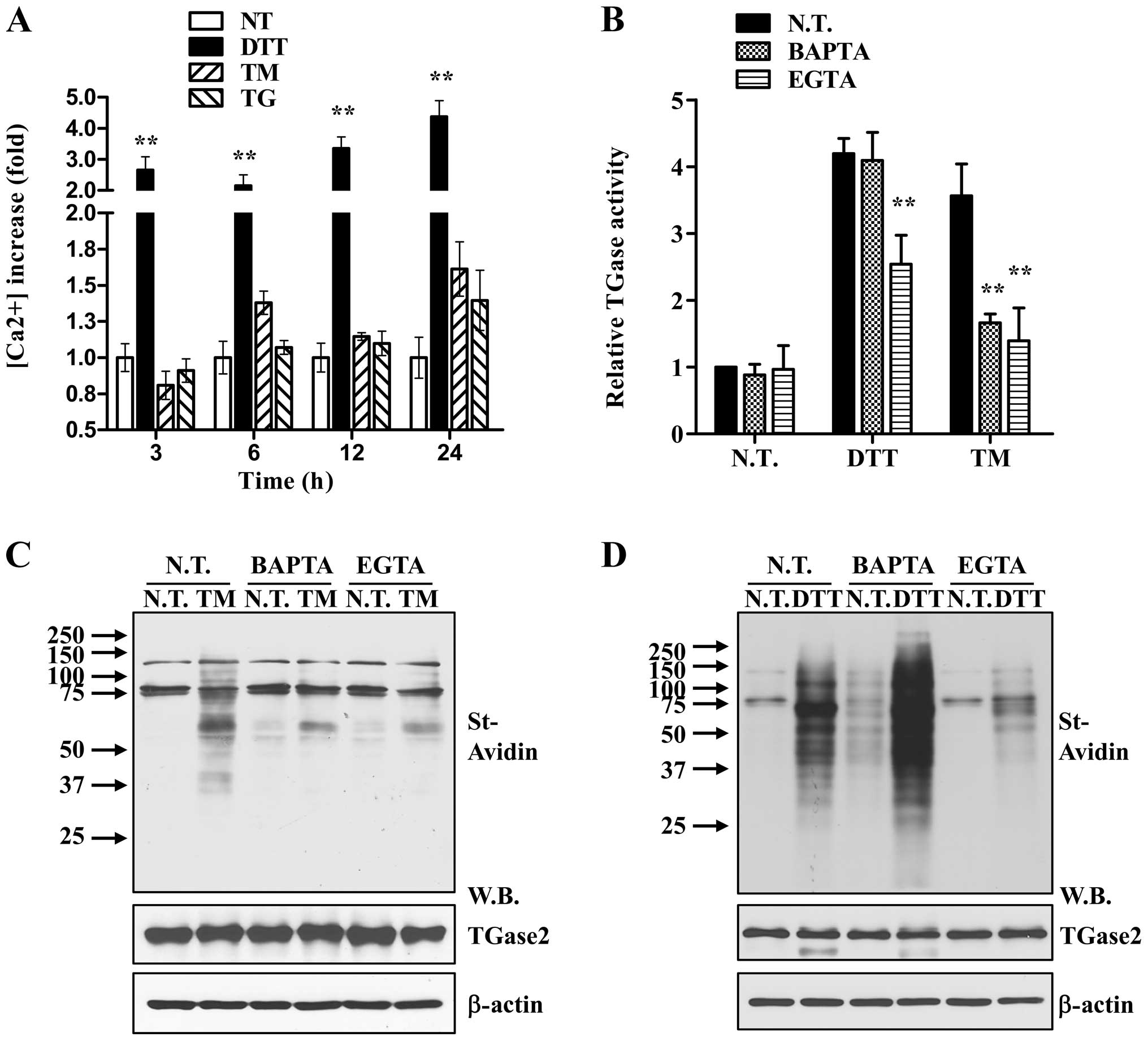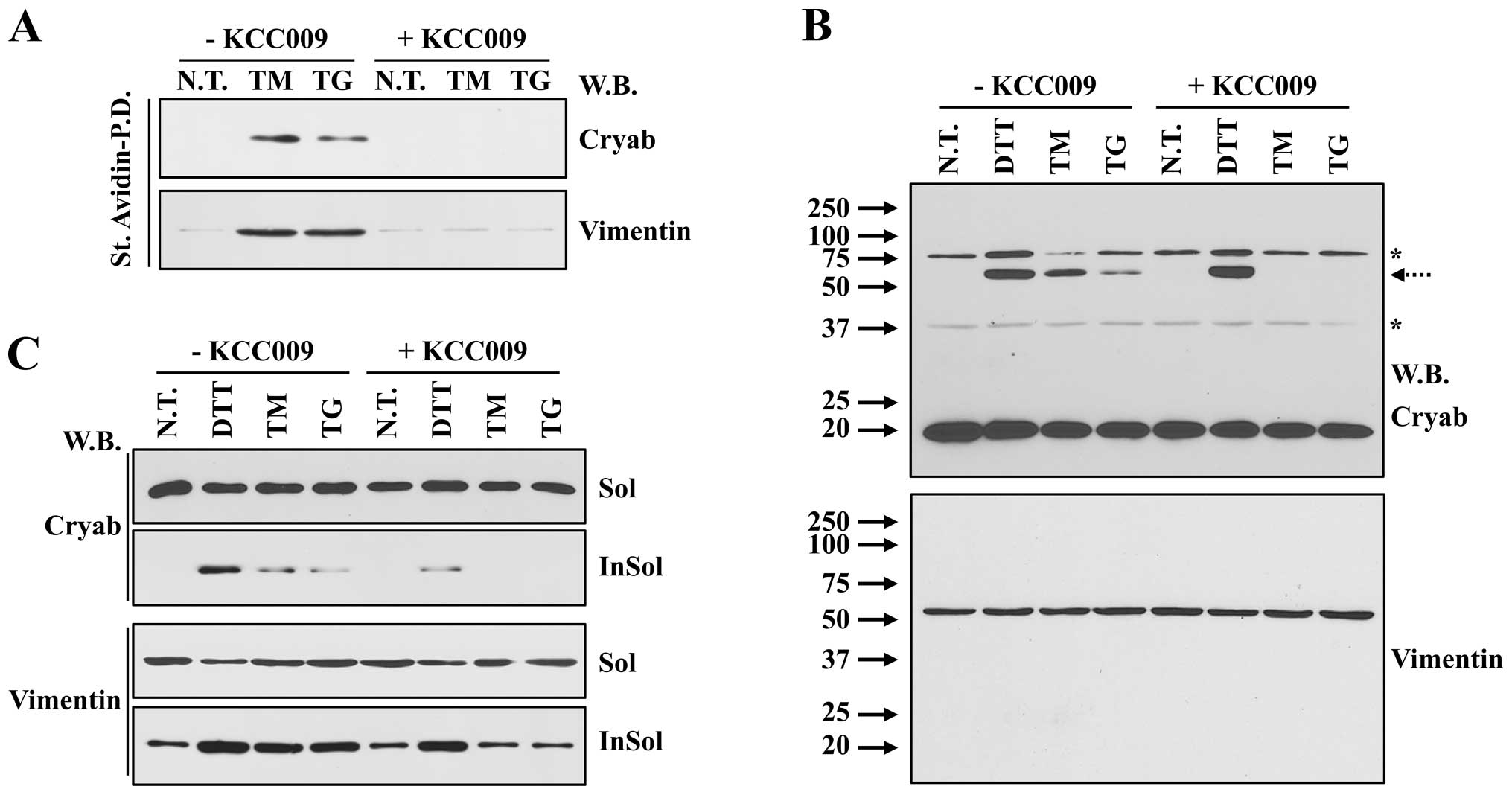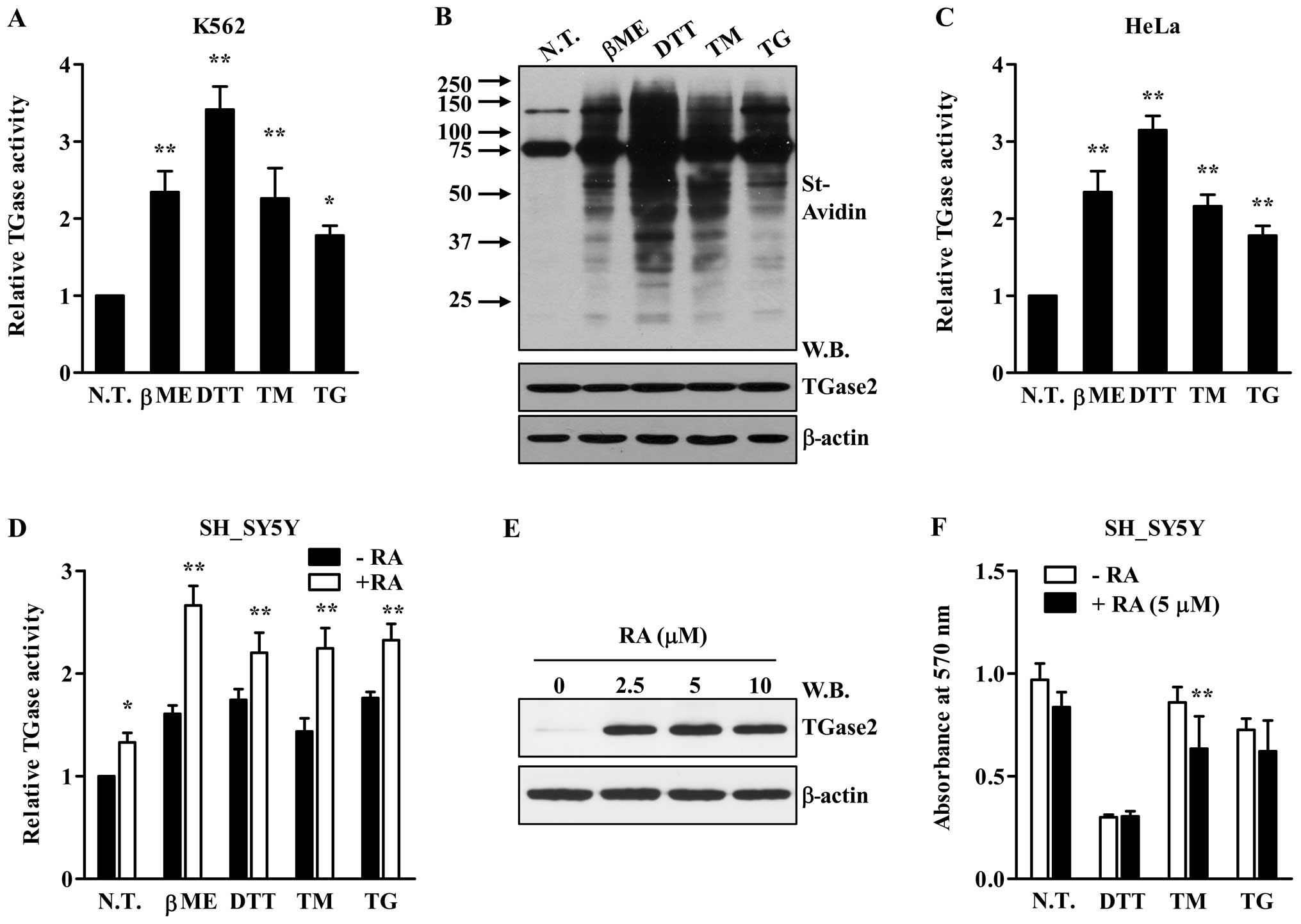|
1
|
Hartl FU, Bracher A and Hayer-Hartl M:
Molecular chaperones in protein folding and proteostasis. Nature.
475:324–332. 2011. View Article : Google Scholar : PubMed/NCBI
|
|
2
|
Lin MT and Beal MF: Mitochondrial
dysfunction and oxidative stress in neurodegenerative diseases.
Nature. 443:787–795. 2006. View Article : Google Scholar : PubMed/NCBI
|
|
3
|
Bence NF, Sampat RM and Kopito RR:
Impairment of the ubiquitin-proteasome system by protein
aggregation. Science. 292:1552–1555. 2001. View Article : Google Scholar : PubMed/NCBI
|
|
4
|
Lorand L and Graham RM: Transglutaminases:
crosslinking enzymes with pleiotropic functions. Nat Rev Mol Cell
Biol. 4:140–156. 2003. View
Article : Google Scholar : PubMed/NCBI
|
|
5
|
Klöck C and Khosla C: Regulation of the
activities of the mammalian transglutaminase family of enzymes.
Protein Sci. 21:1781–1791. 2012.PubMed/NCBI
|
|
6
|
Prasanna Murthy SN, Velasco PT and Lorand
L: Properties of purified lens transglutaminase and regulation of
its transamidase/crosslinking activity by GTP. Exp Eye Res.
67:273–281. 1998.PubMed/NCBI
|
|
7
|
Jeitner TM, Bogdanov MB, Matson WR, et al:
Nɛ-(γ-l-Glutamyl)-l-lysine (GGEL) is increased in cerebrospinal
fluid of patients with Huntington’s disease. J Neurochem.
79:1109–1112. 2001.
|
|
8
|
Konno T, Morii T, Hirata A, Sato S, Oiki S
and Ikura K: Covalent blocking of fibril formation and aggregation
of intracellular amyloidgenic proteins by
transglutaminase-catalyzed intramolecular cross-linking.
Biochemistry. 44:2072–2079. 2005. View Article : Google Scholar
|
|
9
|
Halverson RA, Lewis J, Frausto S, Hutton M
and Muma NA: Tau protein is cross-linked by transglutaminase in
P301L tau transgenic mice. J Neurosci. 25:1226–1233. 2005.
View Article : Google Scholar : PubMed/NCBI
|
|
10
|
Shin DM, Jeon JH, Kim CW, et al: Cell
type-specific activation of intracellular transglutaminase 2 by
oxidative stress or ultraviolet irradiation: implications of
transglutaminase 2 in age-related cataractogenesis. J Biol Chem.
279:15032–15039. 2004. View Article : Google Scholar
|
|
11
|
Shin D-M, Jeon J-H, Kim C-W, et al: TGFβ
mediates activation of transglutaminase 2 in response to oxidative
stress that leads to protein aggregation. FASEB J. 22:2498–2507.
2008.
|
|
12
|
Moore KA and Hollien J: The unfolded
protein response in secretory cell function. Annu Rev Genet.
46:165–183. 2012. View Article : Google Scholar : PubMed/NCBI
|
|
13
|
Lin JH, Walter P and Yen TS: Endoplasmic
reticulum stress in disease pathogenesis. Annu Rev Pathol.
3:399–425. 2008. View Article : Google Scholar
|
|
14
|
Schröder M and Kaufman RJ: The mammalian
unfolded protein response. Annu Rev Biochem. 74:739–789. 2005.
|
|
15
|
Xin W, Li X, Lu X, Niu K and Cai J:
Involvement of endoplasmic reticulum stress-associated apoptosis in
a heart failure model induced by chronic myocardial ischemia. Int J
Mol Med. 27:503–509. 2011.PubMed/NCBI
|
|
16
|
Wu LF, Wei BL, Guo YT, et al: Apoptosis
induced by adenosine involves endoplasmic reticulum stress in EC109
cells. Int J Mol Med. 30:797–804. 2012.PubMed/NCBI
|
|
17
|
Harding HP, Zhang Y, Zeng H, et al: An
integrated stress response regulates amino acid metabolism and
resistance to oxidative stress. Mol Cell. 11:619–633. 2003.
View Article : Google Scholar : PubMed/NCBI
|
|
18
|
Cho S-Y, Lee J-H, Bae H-D, et al:
Transglutaminase 2 inhibits apoptosis induced by calcium overload
through down-regulation of Bax. Exp Mol Med. 42:639–650. 2010.
View Article : Google Scholar : PubMed/NCBI
|
|
19
|
Jang GY, Jeon JH, Cho SY, et al:
Transglutaminase 2 suppresses apoptosis by modulating caspase 3 and
NF-kappaB activity in hypoxic tumor cells. Oncogene. 29:356–367.
2009. View Article : Google Scholar : PubMed/NCBI
|
|
20
|
Choi K, Siegel M, Piper JL, et al:
Chemistry and biology of dihydroisoxazole derivatives: selective
inhibitors of human transglutaminase 2. Chem Biol. 12:469–475.
2005. View Article : Google Scholar : PubMed/NCBI
|
|
21
|
Jeon JH, Choi KH, Cho SY, et al:
Transglutaminase 2 inhibits Rb binding of human papillomavirus E7
by incorporating polyamine. EMBO J. 22:5273–5282. 2003. View Article : Google Scholar : PubMed/NCBI
|
|
22
|
Fesus L and Piacentini M: Transglutaminase
2: an enigmatic enzyme with diverse functions. Trends Biochem Sci.
27:534–539. 2002. View Article : Google Scholar : PubMed/NCBI
|
|
23
|
Caccamo D, Condello S, Ferlazzo N, Currò
M, Griffin M and Ientile R: Transglutaminase 2 interaction with
small heat shock proteins mediate cell survival upon excitotoxic
stress. Amino Acids. 44:151–159. 2013. View Article : Google Scholar : PubMed/NCBI
|
|
24
|
Kweon SM, Lee ZW, Yi SJ, et al: Protective
role of tissue transglutaminase in the cell death induced by
TNF-alpha in SH-SY5Y neuroblastoma cells. J Biochem Mol Biol.
37:185–191. 2004. View Article : Google Scholar : PubMed/NCBI
|
|
25
|
Wakshlag JJ, Antonyak MA, Boehm JE, Boehm
K and Cerione RA: Effects of tissue transglutaminase on
beta-amyloid1–42-induced apoptosis. Protein J. 25:83–94.
2006.PubMed/NCBI
|
|
26
|
Candi E, Schmidt R and Melino G: The
cornified envelope: a model of cell death in the skin. Nat Rev Mol
Cell Biol. 6:328–340. 2005. View
Article : Google Scholar : PubMed/NCBI
|
|
27
|
Muszbek L, Bereczky Z, Bagoly Z, Komáromi
I and Katona É: Factor XIII: a coagulation factor with multiple
plasmatic and cellular functions. Physiol Rev. 91:931–972. 2011.
View Article : Google Scholar : PubMed/NCBI
|
|
28
|
Mukherjee DC, Agrawal AK, Manjunath R and
Mukherjee AB: Suppression of epididymal sperm antigenicity in the
rabbit by uteroglobin and transglutaminase in vitro. Science.
219:989–991. 1983. View Article : Google Scholar : PubMed/NCBI
|
|
29
|
Lee S-M, Jeong EM, Jeong J, et al:
Cysteamine prevents the development of lens opacity in a rat model
of selenite-induced cataract. Invest Ophthalmol Vis Sci.
53:1452–1459. 2012. View Article : Google Scholar : PubMed/NCBI
|
|
30
|
Király R, Demény M and Fésüs L: Protein
transamidation by transglutaminase 2 in cells: a disputed
Ca2+-dependent action of a multifunctional protein. FEBS
J. 278:4717–4739. 2011.PubMed/NCBI
|
|
31
|
Sue Menko A: Lens epithelial cell
differentiation. Exp Eye Res. 75:485–490. 2002.PubMed/NCBI
|
|
32
|
Junn E, Ronchetti RD, Quezado MM, Kim SY
and Mouradian MM: Tissue transglutaminase-induced aggregation of
alpha-synuclein: implications for Lewy body formation in
Parkinson’s disease and dementia with Lewy bodies. Proc Natl Acad
Sci USA. 100:2047–2052. 2003.PubMed/NCBI
|
|
33
|
Karpuj MV, Becher MW, Springer JE, et al:
Prolonged survival and decreased abnormal movements in transgenic
model of Huntington disease, with administration of the
transglutaminase inhibitor cystamine. Nat Med. 8:143–149. 2002.
View Article : Google Scholar : PubMed/NCBI
|
|
34
|
Mastroberardino PG, Iannicola C, Nardacci
R, et al: ‘Tissue’ transglutaminase ablation reduces neuronal death
and prolongs survival in a mouse model of Huntington’s disease.
Cell Death Differ. 9:873–880. 2002.
|



